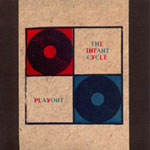
CDR, Zhelezobeton, 2007
zhb.radionoise.ru
Jim DeJong’s project The Infant Cycle has been active on the underground experimental scene since 1994 and particularly on the cassette scene of the early to mid 90’s. Experimental in every sense of the word, DeJong uses simple sound sources to create pulses and noises of various types to use as the basis for his compositions. “Playout” is no exception; the sound sources used for this recording are a carved vinyl record groove and the operating sounds of a record player (augmented by violin bow on the tone arm and a razor blade on the platter).
“Playout” follows a lengthy series of mostly cassette and some CDR releases along with a series of clear shaped vinyl singles on mainly Canadian and European labels. Comprising of just two tracks – “How to Bow a Tone Arm” and “Skinning the Platter” – DeJong’s latest album takes essentially quite basic sounds and reconstructs them into a 30 minute experiment in aural manipulation.
The first of the two tracks, “How to Bow a Tone Arm”, is a low grinding track augmented with the amplified crackles and scrapes the tone arm collects. The mood is generally energetic, anxious or edgy, almost desperate at times. Sounds come in and out of the mix, either loud droning grinds or gentler more atmospheric tonal sounds generated from the bow on the tone arm. “Skinning the Platter” is slightly more rhythmic with an occasional bassy echoed beat over swooping atmospherics giving way to rounded almost tribal clunks and screeching high-pitched tones. The second track is the most minimal of the pair, concentrating more on the detail of the sound and mood it creates. The resultant experience is desolate, windswept and harrowing in presentation, creating an atmosphere of an uninhabited industrial landscape and the weird unidentified sounds it creates from the darkness.
DeJong, similar to the great and respected Aube, uses the simplest of sound sources to base “Playout” on and, by combining harsher and gentler tones from the limited sources at his disposal, creates two tracks of differing mood and presence. Both have their merits and contrasting styles but both are equally intriguing and present DeJong as an artist with a refined and well-versed ability to manipulate and reconstruct source sounds into something completely new and interesting.
[8/10]
— Paul Lloyd
